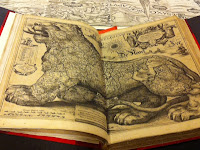This is the second year that a group of Birkbeck students have attended a 'hands on' session at the BL. The topic last year was cities but if they had plenty to show us then, they were able to totally spoilt us with this wide remit. As the curators of the national map collection, they hold over four million maps and they are free for anyone with a BL reader card to request, view and consult.
What I really want to emphasis here, as with any of my posts about archive/library visits, most artefacts, prints, paintings, maps, collections are publically accessible and staffed by knowledgeable and informative librarian and information people to help you discover amazing new things. As the curator stated, 'maps are still relatively unplumbed by students of early modern history'. Never mind them, just imagine modern designers looking for inspiration, novelists looking for fanciful geographies, or - and I admit I am rather romantically inclined - finding pirate treasure island maps? Given that we were to cover shipping and piracy later in the course, this prescience wasn't totally misplaced.
As he demonstrates in his blog post he provided us with cartographic examples from a span of years from 1300s to 1700s; from the schematic, biblical, legal, literary, anthropomorphic, panoramic, defensive, diplomatic and detailed atlases for merchants. All were represented showing the wide range of people who had their own reasons for putting rivers on the map.
The small group poured over each map as they were discussed, with each of us able to then find a map which interested us individually. For me, the one that thrilled me most was the Claesz Jansz Visscher of 1616. Having already spent a lot of time with Hollar's Long View which is at the RA, I was pleased to see one of Hollar's predecessor's maps close up. The detail these panoramas afford never fails to inspire and their size is breathtaking.
 |
| Go and look at the original image! |
So next time you have a yearning to travel into the past, head down to the BL and request some maps.

No comments:
Post a Comment